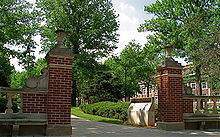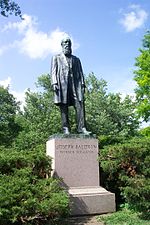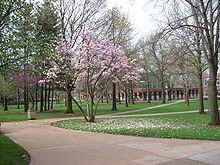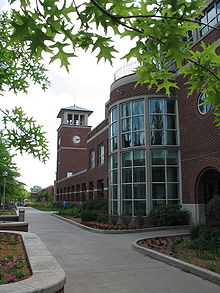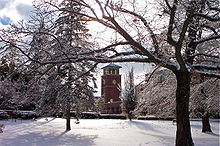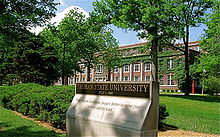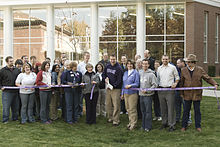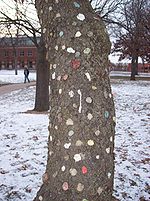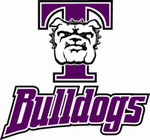- Truman State University
-
Truman State University 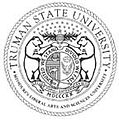
Seal of Truman State UniversityEstablished 1867 Type Public Endowment $23.4 million[1] President Troy Paino Academic staff 344[2] Students 5,866[3] Undergraduates 5,608 Location Kirksville, Missouri, United States Campus Rural, 140 acres (56.7 ha) Former names North Missouri Normal and Commercial School, North Missouri Normal School, North Missouri Normal School of the First District, Northeast Missouri State Teachers' College, Northeast Missouri State College, Northeast Missouri State University Athletics NCAA Division II, MIAA Colors Purple and White Nickname Bulldogs Mascot Spike and Simone[4] Website www.truman.edu 
Truman State University is a public liberal arts and sciences university in Missouri, United States and a member of the Council of Public Liberal Arts Colleges. About 6,000 students attend Truman, pursuing degrees in 43 undergraduate and 9 Graduate programs. It is located in Kirksville in northeastern Missouri and named after President Harry Truman, the only President born in the state. Until 1996, the school was known as Northeast Missouri State University when the name was changed to better reflect their statewide mission. In the 2012 U.S. News & World Report, Truman was again ranked 8th in the Midwest among regional universities, the highest ranking in this category for a school in Missouri .[5] Notwithstanding its 74% acceptance rate, Truman State is the only public institution in the state officially designated to have highly selective admissions standards.[6][7]
Contents
History
Truman State University was founded in 1867 by Joseph Baldwin as the First Missouri Normal School and Commercial College. Baldwin was considered a pioneer in education, and his school quickly gained official recognition in 1870 by the Missouri General Assembly, which designated it as the first public teaching college in Missouri.
25 Missouri counties were designated as the school's college district, including Adair, Audrain, Boone, Callaway, Chariton, Clark, Howard, Knox, Lewis, Lincoln, Linn, Marion, Macon, Monroe, Montgomery, Pike, Putnam, Ralls, Randolph, St. Charles, Schuyler, Scotland, Shelby, Sullivan and Warren.
No official school colors have ever been selected. However, Basil Brewer wrote the school song "The Purple and White" in 1902, prompting the college to adopt school colors of purple and white. They have remained the school colors since.[8] And in 1915, the bulldog became the official mascot of the college.
In 1924 a fire destroyed Old Baldwin Hall and the library. Both were rebuilt, with $25,000 for the library donated by Samuel M. Pickler, a member of the first graduating class of 1870, former faculty member, and local merchant. The broad pond in the quadrangle (a prominent feature in pre-1924 photographs) was pumped dry in a futile attempt to put out the fire. The depression was filled in with debris from the ruined buildings and covered with grass, now serving as the quadrangle ("Quad") of the campus.
The college was renamed Northeast Missouri State University in 1972, and, in 1983, the university was awarded the G. Theodore Mitau Award for Innovation and Change in Higher Education by the American Association of State Colleges and Universities. Northeast Missouri State continued pushing for excellence. On June 20, 1985, Governor John Ashcroft signed a bill that designated the university as Missouri's only statewide public liberal arts and sciences university. This changed the school's mission to a state-wide rather than a regional (northeast) objective. As such, nearly 100 programs were dropped in the span of six years, including all two-year programs that did not fulfill the liberal arts mission.
The school continued to win praise from such publications as US News and World Report and the university's reputation continued to spread. By the 1990s, the university was no longer solely a teachers' college, but also had a nationally-known accounting division and schools of science, mathematics, computer science and literature. Ten years after Governor Ashcroft's designation, Governor Mel Carnahan signed legislation renaming the school Truman State University. Truman State University is designated by statute as Missouri's premier public liberal arts and sciences institution.
Years Name 1867–68 North Missouri Normal and Commercial School 1868–70 North Missouri Normal School 1870–1918 North Missouri Normal School of the First District 1918–68 Northeast Missouri State Teachers College
(Commonly called Kirksville State Teachers College)1968–72 Northeast Missouri State College 1972–96 Northeast Missouri State University 1996–present Truman State University Academic mission
On June 15, 2007, the Board of Governors approved and adopted the University Strategic Plan. In this plan the university will continue its devotion to providing a liberal arts education that is financially accessible. The primary vision, as stated by the Plan, is for Truman to be "America’s premier public liberal arts and sciences university."[4] The Plan also lists six goals that outlines an agenda that will be implemented in the next three to five years.
As part of its focus on liberal arts and sciences, Truman requires all students to complete the Liberal Studies Program [5], or LSP. The LSP is designed to give students a "broad educational experience", and consists of Essential Skills, Modes of Inquiry, and Interconnecting Perspectives sections.
Administration and Organization
University presidents
- Joseph Baldwin (1867–81)
- William P. Nason (1881–82)
- Joseph Blanton (1882–91)
- William D. Dobson (1891–99)
- John R. Kirk (1899–1925)
- Eugene Fair (1925–37)
- Walter H. Ryle (1937–67)
- F. Clark Elkins (1967–69)
- Eli F. Mittler (1969–70)
- Charles J. McClain (1970–89)
- Robert A. Dager (1989–90)
- Russell G. Warren (1990–94)
- W. Jack Magruder (1994–2003)
- Barbara Dixon (2003–08)
- Darrell Krueger (interim) (2008–10)
- Troy Paino (2010–present)
Board of Governors
Truman State's Board of Governors consists of ten members. Each member is appointed by the Governor of Missouri to serve a four-year term, with a student representative serving for two years. The ten members must meet residential requirements defined by Missouri law as follows:
- Four voting members from inside Truman's regional boundary, provided that not more than one person from the same county is selected.
- Three voting members from in-state, provided that not more than one person is from the same college region defined by Missouri state law.
- Two non-voting members from out-of-state. Former U.S. Housing and Urban Development secretary Alphonso Jackson, a graduate of Truman, served on the board in this capacity for two terms.
- One non-voting member who is a current full-time Truman student. Student groups have lobbied the state to allow this member to vote. The Truman Student Senate recently[when?] passed a unanimous resolution calling for a student to become a voting member of the Board of Governors and sent the resolution to every member of the Missouri Legislature.
The current Board of Governors includes the following members:[9]
- Chair - Matthew W. Potter, St. Louis
- Vice Chair - John W. Siscel, III, St. Louis
- Secretary - Kenneth L. Read, Kirksville
- Cheryl J. Cozette, Columbia
- Mike Greenwell, Shelbina
- Karen Haber, Kansas City
- Mark S. Wasinger, Hannibal
Board Members – Nonvoting – Out-of-State
- John Hilton, Alexandria, Virginia
- Michael A. Zito
Board Member – Nonvoting – Student Representative
- Luke Freeland, Kirksville
The Board of Governors also includes four committees: the Finance and Audit Committee, the Budget and Capital Projects Committee, the Honorary Degrees Committee, and the Truman State University Foundation Board of Directors.[10]
Campus
The campus is located on the south side of Kirksville. Truman's main campus is situated around a slightly wooded quadrangle, also known as the "Quad." It is two blocks south of the town square, which includes an eight screen movie theatre and various eateries.
Notable buildings on campus include Pickler Memorial Library, the Kirk Memorial, the Kirk Auditorium Building (the oldest building on campus, built in 1922), Magruder Hall, McClain Hall, Baldwin Hall, Violette Hall, Barnett Hall, Ophelia Parrish, Pershing Arena and the Recreation Center (or "The Rec").
Pickler Memorial Library was named after Samuel M. Pickler, who donated funds to rebuild the library after it was destroyed by fire in 1924. Renovated in 1993, it now houses the main computer lab, as well as approximately 500,000 volumes of various works. The front lobby area of Pickler Memorial Library is known as "the Bubble" for its curved glass atrium.
Kirk Memorial is a small, domed structure near the center of campus. The structure is dedicated to John Kirk, the fifth president of the university. It formerly housed Truman's debate team and now houses a few administrative offices. The Kirk Auditorium, now known as "Kirk Building," was once the University's combined gymnasium and auditorium facility. It currently houses the Center for International Education, Student Affairs, Publications and the Department of Sports Information. The Rec is located just north of Centennial Residence Hall and is open everyday except on holidays. It also offers a gymnasium for a variety sports, a weight room, an elevated track, various exercise equipment, and a smaller, multipurpose gym for hockey, indoor soccer, etc. There are seven main academic buildings. Magruder Hall is the science building and houses the departments of Chemistry, physics, Biology and Agriculture. McClain Hall serves as both an administrative and academic building. For the academic portion, Classical & Modern Languages, Economics, English & Linguistics, History, Philosophy & Religion, Political Science and Psychology can be found there. Baldwin Hall is connected to McClain Hall and houses the campus auditorium that is best known for hosting cultural events through the Kohlenberg-Lyceum Series. Violette Hall, named after former history professor E.M. Violette, is home to the School of Business, the Mathematics and Computer Science Department and the Education Department. Ophelia Parrish is used as home to the Art, Music and Theatre Departments. Barnett Hall is home to the departments of Anthropology, Geography and Sociology; Communication; Communication Disorders; Justice Systems; and Nursing programs. Finally, Pershing Arena is for department of Health and Exercise Science classes.
Services available on campus to students include the student health center, career center and writing center. General use of the health center is free, but it is closed on the weekends and holidays. The career center is located next to the health center and provides help to students in determining a career path, selecting a major, developing career skills, helping put together a resume, or even conducting mock interviews. The writing center is located on the third floor of McClain and offers critique and editing for student papers.
Academics
Admissions
In order to be accepted to the university, applicants must have a combined ability score of at least 140. The combined ability score is calculated by adding the percentage of students in the applicant's graduating class that the applicant outranks and the percentage of students the applicant outscored on a nationally-standardized test (usually the ACT, although the SAT is also accepted). Admissions decisions are also based, however, on a mandatory application essay, the applicant's resume, and the applicant's high school and extracurricular record. According to the Princeton Review, Truman has a selectivity rating of 97, a 79% acceptance rate, and an 85% retention rate.[11] All applicants must have 4 credits of English, 3 credits of math, 3 credits of science, 2 credits of foreign language, 2 credits of social studies, and 1 credit of fine art. The average GPA of an admitted student is 3.76, with 50% of all admitted students ranking in the top 10% of their class, and the median ACT range is 25–31.
The Liberal Studies Program
On July 20, 1985, the state of Missouri charged Truman State University with serving as the state's premier public liberal arts and sciences university. In order to meet this commitment to the people of Missouri, the Truman faculty and administration created the Liberal Studies Program, the general education curriculum undergraduates complete in order to receive a Truman degree. The Liberal Studies Program consists of three distinct areas:
- Essential Skills for success in liberal studies, including courses in writing as critical thinking, public speaking, elementary functions, statistics, computer literacy and personal well-being.
- Modes of Inquiry by which students may approach problems and issues in other academic areas. Students must complete coursework in seven of the following eight modes: fine arts, literature, history, mathematics, philosophy or religion, life science, physical science and social science.
- Interconnecting Perspectives that allow students to understand and appreciate better the knowledge they have gained. This includes taking a series of writing-enhanced courses, an interdisciplinary seminar course in the junior year, at least two semesters of a foreign language, and participating in an intercultural experience (this can be fulfilled through any one of a series of courses or by going on any study abroad trip).
Schools
The School of Arts and Letters is the home of the departments of Art, Classical & Modern Languages, English & Linguistics, Music and Theatre. Degrees offered through the school include Art, Art History, Classics, English, French, German, Linguistics, Music, Romance Languages, Russian, Spanish, Theatre and Visual Communications. In addition to the 17 distinct undergraduate majors offered, the school also offers 6 graduate programs, including Music and English.[12]
The School of Business offers degrees in Business Administration (BA or BS) with emphasis in Finance, Management, Marketing and International Business. In addition, a BS and MAc in Accounting are offered, with the graduate program ranked third in the nation in terms of CPA passage rates.[13]
The School of Health Sciences & Education offers degrees Communication Disorders (graduate and undergraduate), Nursing, Health Science, Exercise Science and Education (MAE only). Education students can emphasize in elementary education, special education, English, exercise science, foreign language, music, mathematics, science and visual arts.[14]
The School of Science and Mathematics offers degrees in Agricultural Science, Biology, Chemistry, Mathematics, Computer Science, Physics and Psychology.[15] The school also offers Missouri's only undergraduate interdisciplinary degree program in mathematical biology,[16] and it coordinates the Missouri Pre-STEM Pathways Program [17] with Moberly Area Community College, Metropolitan Community College - Kansas City, and St. Charles Community College.
The School of Social & Cultural Studies offers degrees in Communication, Economics, History, Justice Systems, Military Science (minor only), Philosophy & Religion, Political Science, Geography (minor only) and Sociology/Anthropology.[18]
Students are also free to create their own interdisciplinary majors or to minor in any of the approved interdisciplinary minors, which include African/African-American Studies, Asian Studies, Classical Studies, Cognitive Sciences, Environmental Studies, Folklore, Forensic Science, International Studies, Italian Studies, Mathematical Biology, Medieval Studies and Women's and Gender Studies.[19]
Campus Life
Residence Life
In the 1960s the university built Dobson Hall (1961), Ryle Hall (1963), Missouri Hall (1965) and Centennial Hall (1967). There are three other residence halls on campus: Blanton-Nason-Brewer (1948, Brewer added in 1959), Ezra C. Grim Hall (1923), and West Campus Suites (2006). The residence halls are maintained by ResLife, an administrative body of professionals and students who live in the halls and act as student advisors (SA's) and hall directors. Truman's residence halls are currently undergoing a $90 million renovation schedule. This project included the construction of West Campus Suites in 2006, the renovation of Missouri Hall in 2006, Blanton-Nason-Brewer in 2007, and Dobson in 2008. Ryle Hall is currently in the first phase of a two-year renovation, and Centennial is scheduled to undergo a two-year renovation after Ryle.
Dobson Hall is coed by wing and houses roughly 400 students. Dobson features community-style bathrooms, study areas, laundry facilities, air conditioning in all rooms and a convenience store, but no cafeteria.[20]
Ryle Hall is the second largest hall at Truman. This coed dorm houses nearly 600 students in suite-style rooms. The standard arrangement is two bedrooms, or four people, sharing one bathroom. Ryle has a spacious main lounge that is often used for on-campus events. The dorm features a cafeteria, computer labs, mailboxes, vending machines, automated teller machines (ATMs), laundry rooms, and also house a classroom used by the Residential College Program (RCP). Ryle will be undergoing renovations from 2009–2011. The North wing and main lounge of Ryle will be closed and remodeled during the 2009–2010 academic year, reopening in August 2010. The South wing of Ryle will be closed and remodeled during the 2010–2011 academic year, reopening in August 2011. Renovation plans also include remodeling the Ryle cafeteria during the summer of 2009.[21]
Centennial Hall (commonly called "C-Hall") is the largest residence hall on campus. This coed hall houses nearly 600 students in suite-style rooms. Like Ryle, the standard arrangement is two rooms, or four people, sharing one bathroom. Centennial also has a spacious main lounge that is often used for small on-campus events. The dorm features a cafeteria, computer labs, mailboxes, vending machines, ATMs, laundry rooms and also a large study lounge. The primary difference between Ryle and Centennial is that Ryle's lounge is located on the first floor with its cafeteria below, and that Centennial's cafeteria bisects the second floor, with the lounge area sitting directly below. Centennial will be the final dorm renovation on Truman's campus, completing a seven year renovation schedule of all of the residence halls. The hall renovated similarly to Ryle, in 2 stages, the first from 2011–2012 and the second from 2012–2013.[22]
Missouri Hall (commonly called "MO Hall") is a coed residence hall that houses 518 students, making it the third largest on campus. Missouri Hall is made up of seven different wings. On both the north and south sides of the building three wings join with a common lounge. The two common lounges are linked by a seventh "crossover" wing. From overhead, the building is shaped like an elongated asterisk. While each wing is either male or female, each "house" (the north or south side of a single floor) includes both male and female wings. The building also houses a large cafeteria, study rooms, laundry facilities and many public kitchens. With a high percentage of first year students each fall term, more students get their start at Truman in Missouri Hall than any other place on campus.A renovation of Missouri Hall began in the summer of 2006 and concluded during the summer of 2007. The upgrade included improved air conditioning, renovated bathrooms, wiring upgrades, improved community space, an updated dining hall, and a new lobby.[23]
Blanton-Nason-Brewer (commonly called "BNB"), offers three floors of suite-style, coed living arrangements to students. Originally three separate buildings connected by breezeways, the building underwent a major renovation in the 2007–2008 academic year and is now one, unified residence hall. The north wing, Brewer Hall, is primarily used as sorority housing. The east and south wings, respectively Nason Hall and Blanton Hall, are used as regular housing. BNB does not have its own dining hall, so residents typically walk to Missouri Hall, which is next door. The hall offers two large lounges with fireplaces on the first floor. The second and third floors have open community lounge areas, study rooms, computer workstations, laundry facilities, trash and recycling areas, and public kitchens.[24]
Grim Hall is the smallest residence hall on campus, with a capacity of just 68 residents. It is also unusual in its hardwood flooring and house-like appearance. Originally a dormitory for nurses at the adjacent Grim-Smith Hospital, it was later acquired by the University in the 1930s. For many years Grim was also the "International Dorm" by striving to maintain a population of at least one third foreign students. Because of its small size, Grim Hall sometimes feels more like a home than a large housing complex; much of its personality comes from its residents differentiating Grim from the large dormitories.[25]
West Campus Suites, just northwest of Centennial Hall, opened its doors to 416 students in Fall 2006. Currently, all floors are coed by suite and the building's residents come from all class standings. Each room (with the exception of single rooms for eight student advisors and apartments for the hall director and community coordinator) consists of two bedrooms attached to a central living room, sink, kitchen cabinets and large bathroom. All suites have individual central air conditioning. Each floor has its own dedicated lounge, 2 study rooms, laundry facilities, trash and recycling center, campus events bulletin board, and computer labs. A favorite amenity of students is the convenience store located off of the main lobby.[26]
Truman offers the option of three campus-owned apartments for student living: Randolph, Campbell and Fair. Randolph and Campbell Apartments provide residents with a kitchen area, while students living in Fair Apartments use their meal plan to eat on campus. Fair is located across the street from Violette Hall, Campbell is located next to the tennis courts, and Randolph is located behind Dobson Hall.[27]
Yet another option is Farm Hall, located at the University Farm. Only a handful of students, often majors in agricultural science, live here each year. Their work on the farm helps them gain useful first-hand experience, as well as help pay for room and board.
Student organizations
Truman is host to a variety of student organizations. Option for student involvement include campus media, cultural organization, departmental and professional groups, Greek life, honorary societies, political groups, recreational sporting organizations, religious communities, service groups and Student Government.[28]
Greek Life
The Greek community contains almost 20% of the campus in nineteen fraternities and eleven sororities.[29]
Interfraternity Council (IFC)
IFC governs the 14 men's social fraternities on campus:
- Alpha Gamma Rho
- Alpha Kappa Lambda
- Alpha Tau Omega
- Beta Theta Pi
- Delta Chi
- Kappa Alpha Psi
- Lambda Chi Alpha
- Pi Kappa Phi
- Sigma Tau Gamma
- Sigma Phi Epsilon
- Tau Kappa Epsilon
- Phi Kappa Theta
- Phi Kappa Tau
- Phi Lambda Phi [6]
- Phi Sigma Kappa
Panhellenic Council
The sororities are governed by the Panhellenic Council, which is made up of five internationally recognized social sororities as well as the only local social sorority on campus:
- Alpha Gamma Delta
- Alpha Sigma Alpha
- Delta Zeta
- Sigma Kappa
- Sigma Sigma Sigma
- Sigma Chi Delta
There are several other local sororities: Alpha Sigma Gamma, Beta Omega Beta, Tau Lambda Sigma, and The Primroses.
National Pan-Hellenic Council
There are also seven of the "Divine Nine" National Pan-Hellenic Council historically-black fraternities and sororities:
- Alpha Phi Alpha Fraternity
- Kappa Alpha Psi Fraternity
- Phi Beta Sigma Fraternity
- Alpha Kappa Alpha Sorority
- Delta Sigma Theta Sorority
- Sigma Gamma Rho Sorority
- Zeta Phi Beta Sorority
Multicultural
- Sigma Lambda Gamma Sorority
- Sigma Lambda Beta Fraternity
The organizations do service around the community, provide leadership on campus, and provide a social outlet for students. In addition to these organizations, Truman also boasts an honor fraternity for nearly every major on campus.
Honorary
Truman also offers a wide selection of honorary organizations.[30]
- Alpha Phi Sigma
- Alpha Psi Omega
- Eta Sigma Phi
- Eta Sigma Gamma
- Kappa Delta Pi
- Kappa Mu Epsilon
- Lambda Pi Eta
- National Residence Hall Honorary
- National Society of Collegiate Scholars
- Omicron Delta Kappa
- Phi Beta Kappa
- Phi Kappa Phi
- Phi Sigma Pi
- Pi Delta Phi
- Psi Chi
- Sigma Delta Pi
- Sigma Tau Delta.
In addition, there is the Pershing Society, a special organization for students who have been awarded the Pershing Scholarship, the University's most prestigious award.
International Students
Truman enrolls students from all over the world. According to 2009 figures from the International Student Affair Office, 309 students represent 45 countries, coming from Nepal, China and Vietnam.[31]
Campus Lore
- The weather vane atop Kirk Memorial is welded in place so that it will always point northeast, in honor of the school's previous name and its location.[7]
- "The Ghost of Centennial Hall" is named "Joan," who has been said to be a student killed in an auto accident in the 1970s. In addition, "Charlotte" and an unnamed little boy have haunted Grim Hall for 70 years, and "Gina" watches over the women of Ryle. See external link "Truman Ghost Stories," below.
- Students traditionally stuck their chewing gum on a redbud tree on the east side of campus.[8] This "gum tree" was decorated in colorful wads, and at times, it even sported students' names. The tree was vandalized and knocked down by an unknown party in 2000, but students quickly adopted another tree.
- The sunken garden, site of many student weddings, is actually the cellar left from the Baldwin Hall fire of 1924. Due to the frequency of student weddings in the sunken garden, a campus myth came into common circulation. It is alleged that if a new couple has their first kiss at midnight on one of the two benches located in the sunken garden, the couple will eventually get married.
- A row of large, clapperless bells is fixed in a brick wall on the quad. The Bell Wall was built and dedicated at the Centennial Celebration in 1967. The bells were donated by Joe Burdman, local businessman and University benefactor. The historic bells were collected from abandoned churches, schoolhouses and public buildings in northeast Missouri. Each bell was meant to represent the ideals of liberty, justice, religion, and education.
- The annual football game against Northwest Missouri State University was established in 1930 when Northwest president Uel W. Lamkin sent Fair a polished hickory stick from the farm where the former president Eugene Fair was born. The "Hickory Stick" has since been contested annually. [9]
Army ROTC
Army Reserve Officers' Training Corps (ROTC) was established at Truman in 1969. Approximately 200 Truman students are members of the "Bulldog Battalion" and enroll in military science courses each semester. Students completing the ROTC program are additionally awarded a minor in Military Science.
Athletics
Intercollegiate athletics
Truman is a member of NCAA Division II and plays in the Mid-America Intercollegiate Athletic Association conference. The athletic department sponsors 21 teams, 11 men's and 10 women's. Among Truman's most recent successes include: four regional championships for women's volleyball, a regional berth for men's basketball in 2006, and undefeated regular seasons for both men's and women's soccer. In March 2008, the women's swim team won their seventh NCAA Division II National Championship title in eight years, again beating their in state rival Drury University. The team holds the record for most national titles won in their division.[10] [11]
Men's intercollegiate athletic teams
- Baseball
- Basketball
- Cross Country
- Football
- Golf
- Soccer
- Swimming
- Tennis
- Track & Field
- Wrestling
Women's intercollegiate athletic teams
- Basketball
- Cross Country
- Golf
- Soccer
- Softball
- Swimming
- Tennis
- Track & Field
- Volleyball
Facilities
Indoor sports are played in the Pershing Arena, named for general John J. Pershing who attended Truman the 1880s. Stokes Stadium is the site for home football games and track meets.
Club sports
In addition to NCAA intercollegiate athletics, the university fields a number of club level and recreational teams including: A nationally ranked IHSA Equestrian team, women's lacrosse which competes in the Central Plains Women's Lacrosse League, rugby union (Bulls and Bullets), a nationally ranked roller hockey team- a member of the National Collegiate Roller Hockey Association (NCRHA), ultimate frisbee (JujiTSU and TSUnami), men's volleyball and men's and women's soccer.[32]
Truman students passed a resolution in the Spring of 2007, adding a $50/semester fee to all students taking six or more credit hours to help support athletic facilities on campus. The addition of lights to Stokes Stadium was one of the first projects completed with the help of the student athletic fee.
Notable people associated with Truman
Main article: List of Truman State University alumni- Ray Armstead gold medal winner in the 1984 Olympics (4x400m relay)
- Samuel W. Arnold, former US Congressman from Missouri 1st district.
- Robert J. Behnen, a genealogist and former Republican member of the Missouri House of Representatives;
- Beryl Franklin Carroll, 20th governor of Iowa[33]
- John W. Cauthorn, a former Republican member of the Missouri State Senate;
- Byron Crawford, a blogger and Hip-Hop critic;
- Brian Dzingai, Zimbabwean Olympic sprinter;
- Lenvil Elliott, former professional American football player who played running back for nine seasons in the NFL.
- Jenna Fischer, actress, best known for her role as Pam Beesly, in the U.S. adaptation of The Office
- Kevin C. Fitzpatrick, a non-fiction writer best known for his research of Dorothy Parker and the Algonquin Round Table.
- Harry Gallatin, Truman men's basketball player, NBA player for the New York Knicks and the Detroit Pistons, coach of the New York Knicks and member of the Basketball Hall of Fame
- Alphonso Jackson, 13th United States Secretary of Housing and Urban Development (HUD)
- Glenn Jacobs, WWE wrestler best known as "Kane", played both football and basketball for Truman;
- Harry H. Laughlin, was a leading American eugenicist in the first half of the 20th century;
- Clare Magee, U.S. Representative from Missouri;
- Rebecca McClanahan, RN and professor of Nursing, and former Democratic member of the Missouri House of Representatives;
- Susana A. Mendoza, member of the Illinois House of Representatives;
- Mike Morris, former long snapper for the Minnesota Vikings and a current radio host on KFAN in Minneapolis.
- John R. Murdock, U.S. Representative from Arizona.
- Al Nipper, a Major League Baseball coach and a former pitcher who played for the Boston Red Sox, Chicago Cubs and Cleveland Indians.
- Ken Norton, boxer, one of the few to beat Muhammad Ali;
- Prajwal Parajuly, Nepali-speaking Indian writer whose first two books will be published by Quercus.[34] [35]
- General John J. "Black Jack" Pershing, American Army Officer who achieved rank of General of the Armies;
- Milton Andrew Romjue, U.S. Representative from Missouri.
- Mary Rhodes Russell, judge on the Supreme Court of Missouri, appointed in 2004 and retained in 2006;
- Rob Schneider, Dallas Morning News presentation director and secretary/treasurer of Society for News Design
- Rhonda Vincent, bluegrass singer, International Bluegrass Music Association's female vocalist of the year 2000–2006.
- Arthur L. Willard, U.S. Navy Vice Admiral and winner of the Navy Cross.
- Gregg Williams, Super Bowl-winning defensive coordinator for the New Orleans Saints, Buffalo Bills former head coach.[36]
Notable Faculty/Staff
- Marc Becker, Professor of History, one of the most dangerous academics in America, according to The Professors: The 101 Most Dangerous Academics in America
- Don Faurot, conference champion football and basketball head coach, member of the College Football Hall of Fame
- Huping Ling, Professor of History
- Emmanuel Nnadozie PhD, Nigerian economist, author, educator; founder of the Truman McNair Program
- Marilyn Yaquinto, Assistant Professor of Communication, for being included in Los Angeles Times’ Pulitzer Prize award for Spot News Reporting of 1992 Los Angeles riots and its aftermath in connection with the Rodney King court case.[37]
References
- ^ Foundation Asset Growth
- ^ Truman State University, Missouri
- ^ http://www.truman.edu/index.asp?docld=566&audienceld=
- ^ http://www.index.truman.edu/pdf/2007-2008/august19/page%2010.pdf
- ^ Truman State University - Best College - Education - US News
- ^ [1]
- ^ Truman State University
- ^ "School Colors". http://library.truman.edu/archives/school_colors.asp. Retrieved 5 June 2011.
- ^ Board Members
- ^ Board Officers and Board Committees
- ^ http://www.princetonreview.com/schools/college/CollegeAdmissions.aspx?iid=1022679
- ^ Truman State University
- ^ School of Business - Truman State University
- ^ School of Health Sciences & Education at Truman State University
- ^ School of Science & Math - Truman State University
- ^ Welcome
- ^ Pre-STEM Pathways Program
- ^ Truman State University
- ^ Interdisciplinary Minors
- ^ Dobson Hall - Residence Life - Truman State University
- ^ Ryle Hall - Truman State University
- ^ Centennial Hall - Residence Life - Truman State University
- ^ Missouri Hall - Residence Life - Truman State University
- ^ Blanton Nason Brewer (BNB) - Truman ResLife
- ^ Grim Hall-Index-Truman State University
- ^ West Campus Suites - Home - Truman State University
- ^ http://reslife.truman.edu/halls/apartments/BldgRmInfo.asp
- ^ Center for Student Involvement - Student Organizations
- ^ Greek Life at Truman
- ^ [2]
- ^ Current Statistical Information for International Students for Spring 2011 http://iso.truman.edu/documents/111%20Stats.doc
- ^ All Organizations
- ^ National Governors Association
- ^ http://newsletter.truman.edu/article.asp?id=1768
- ^ http://www.thebookseller.com/news/quercus-invests-youth-rights-deal.html
- ^ [3]
- ^ Marilyn Yaquinto
External links
Mid-America Intercollegiate Athletics Association Central Missouri Mules and Jennies • Central Oklahoma Bronchos (2012) • Emporia State Hornets • Fort Hays State University Tigers • Lincoln Blue Tigers • Lindenwood Lions (2012) • Missouri Southern Lions • Missouri Western Griffons • Nebraska–Kearney Lopers (2012) • Northeastern State RiverHawks (2012) • Northwest Missouri Bearcats • Pittsburg State Gorillas • Southwest Baptist Bearcats • Truman Bulldogs • Washburn Ichabods and Lady Blues
Council of Public Liberal Arts College (COPLAC) Eastern Connecticut State • Evergreen State • Fort Lewis • Georgia College & State University • Henderson State • Keene State • Mary Washington • MCLA • Midwestern State • Minnesota Morris • Montevallo • New College of Florida • Ramapo • Sonoma State • Southern Oregon • St. Mary's (Maryland) • SUNY Geneseo • Truman State • University of Alberta, Augustana Campus • UMaine Farmington • UNC Asheville • University of Science and Arts of Oklahoma • UVA-Wise • UW-Superior
Coordinates: 40°11′21″N 92°34′57″W / 40.18917°N 92.58239°W
Categories:- Educational institutions established in 1867
- Universities and colleges in Missouri
- North Central Association of Colleges and Schools
- American Association of State Colleges and Universities
- Liberal arts colleges
- Harry S. Truman
- Truman State University
Wikimedia Foundation. 2010.

